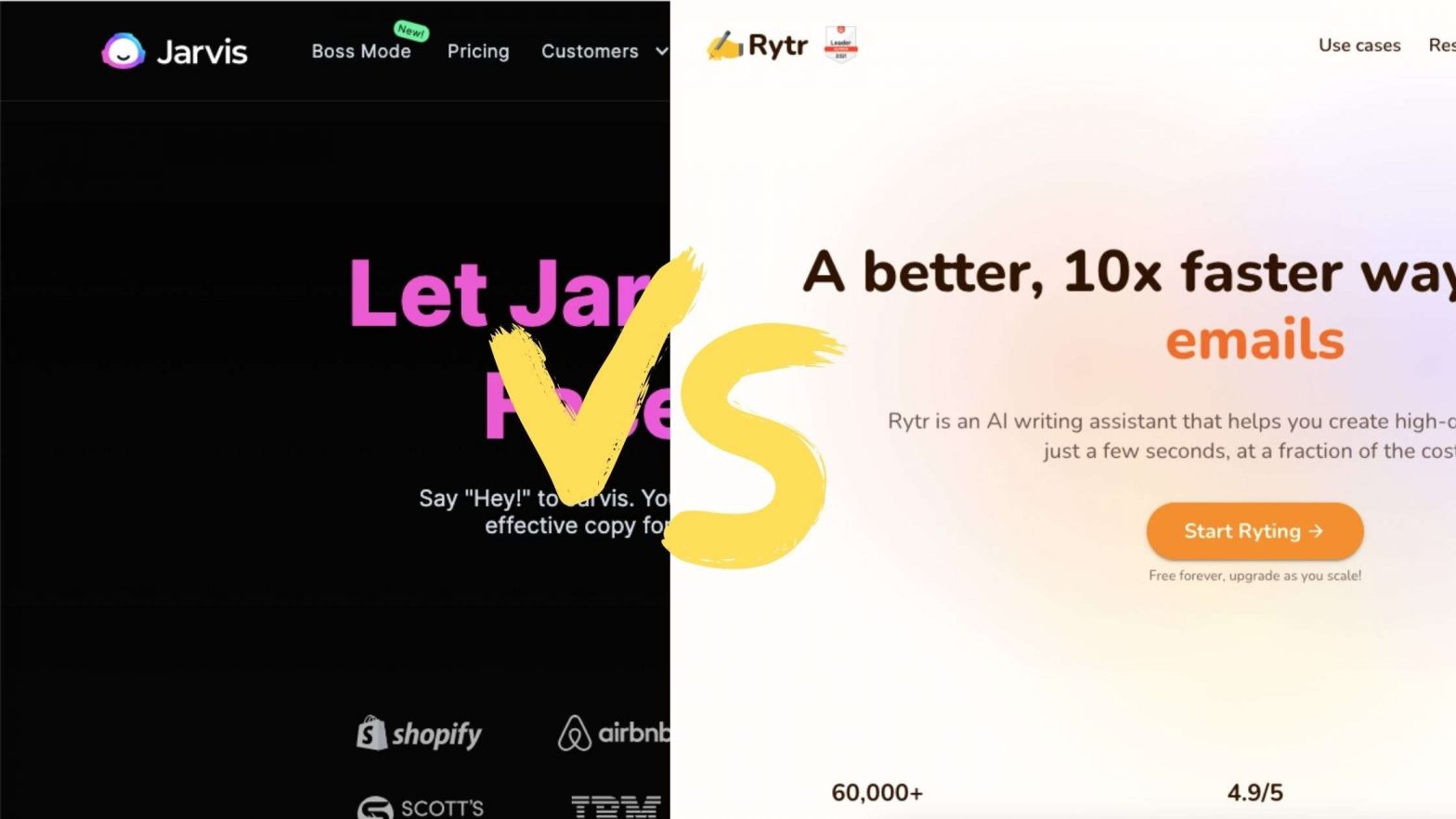Lately, AI copywriting assistants have been all the rage. And for a good reason: these tools can churn out thousands and thousands of words of short- and long-form text on command.
As their creators like to point out, these tools turn writer’s block into a thing of the past as you test tones of voice and spin angles to come up with original and clever-worded content for your ads, blog posts, product descriptions, landing pages, and social profiles.
Almost all AI copywriting assistants on the market today are powered by OpenAI’s GPT-3, an algorithm capable of generating complex and consistent texts for fiction and non-fiction writing.
However, not all are created equal.
Having tested almost all of the tools on the market myself, I can tell you that some are frankly hard to use, and others keep spewing out meaningless content even if you give them the most precise of inputs.
The word out on the street, or should I say Reddit, is that two names in particular—the all-mighty Jarvis and the ultra-affordable Rytr—have trained themselves to become strikingly good at copywriting.
In this post, I will put them to the test side by side, giving you my take on when to go for one and when for the other.
What Is Jarvis?
Jarvis (formerly known as Conversion.ai) is an AI copywriting assistant powered by OpenAI’s GPT-3 algorithm. It supports 25+ languages, has 50+ copywriting templates, and is widely praised for its ability to generate long-form content on command.
Like all tools of its kind, it’s a web app that you use from a browser. Simply select a template, type in a topic and desired tone of voice, select how many variants you want to have generated, and hit the “Generate” button.
Then sit back and watch the magic happen.

You can assign colorful tags to your favorite outputs and sort your documents under folders. The more actively you use Jarvis, the more organized you’ll have to become if you want to be able to look up old content.
Generally speaking, Jarvis is a great tool for content ideation for ads (Facebook and Google), blog posts, YouTube videos, Instagram posts, online stores, and SEO copywriting (titles, meta descriptions, as well as the fluffy part of long-form content).
It’s intuitive, generates high-quality outputs, and is by far the easiest to use AI copywriting assistant I’ve tested.
But it’s also the most expensive.
How Much Does Jarvis Cost?
Jarvis has three pricing plans which, at the time of publishing this post, were available for the prices below and had the following features:
| Plan / Features | Starter | Pro | Boss Mode |
|---|---|---|---|
| Price | $29/month | $109/month | $119/month |
| Price per additional user | N/a | $40/user | $50/user |
| 25+ languages | Yes | Yes | Yes |
| 50+ short-form templates | Yes | Yes | Yes |
| Long-form writing assistant | No | Yes | Yes |
| Jarvis Commands | No | No | Yes |
If you pay annually for any of the plans above, you get 2 months free.
Jarvis Starter ($29/month)
The cheapest plan, called “Starter,” is priced at $29/month and lets you generate up to 20,000 words/month using one of the 50+ copywriting templates.
These templates include the “Content Improver,” with which you can ask Jarvis to rewrite any piece of content up to 600 characters long and with any tone of voice:
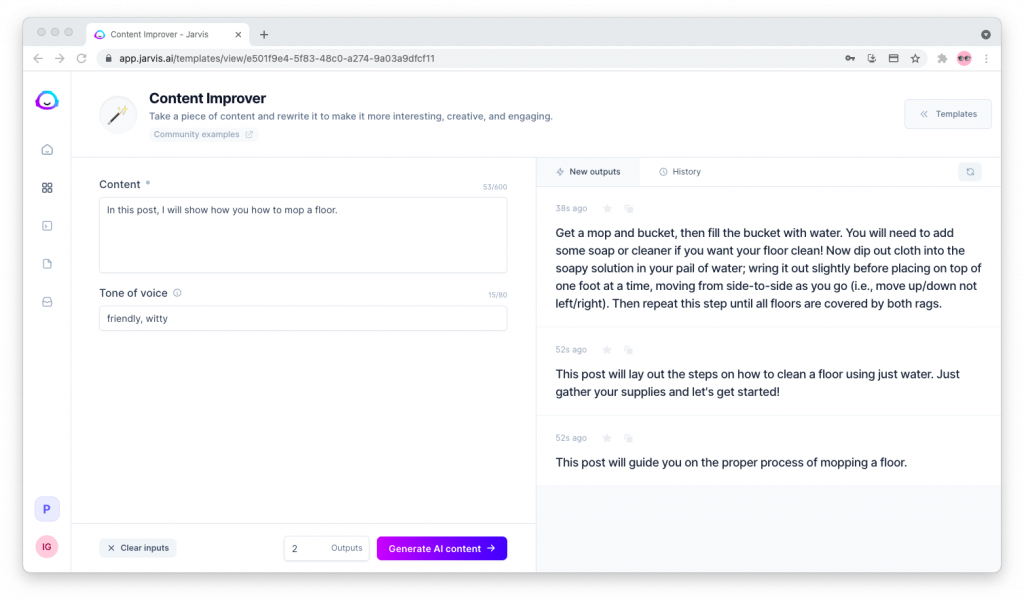
Or of my personal favorite, called “Explain It to a Child,” which lets you take any piece of text that’s packed with jargon and complicated speech, and simplify it to a level that any child would get:
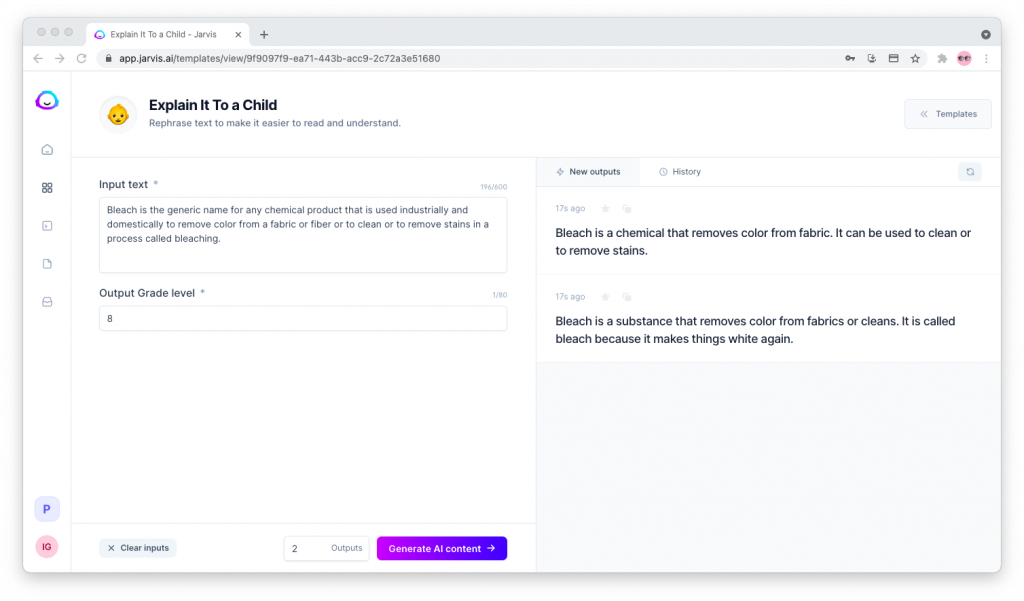
A few other templates worth calling out are the Blog Post Outline, Blog Post Intro, and Blog Post Conclusion; the Facebook Ad Headline and Facebook Ad Primary Text templates; the Instagram Photo Post Captions, as well as the Ideas, Outlines, Titles, Hooks and Introductions, and Descriptions for YouTube videos.
You can see the list of all Jarvis templates here.
20,000 words/month may sound like a sweet deal at first glance. However, I find that constraint to be too limiting, especially if you want to generate multiple variants for your copy needs (which you do, as these tools take a few runs before they can get most texts right).
When you reach the character limit on Jarvis’ Starter plan, you can top up your account with an additional 10,000 characters for $10, or you can upgrade to the Pro or Boss Mode plans (more on them below).
You’ll need to monitor your usage patterns to decide what to do. Compared to topping up, upgrading ends up being cheaper in the long run for most Jarvis users.
The biggest constraint of the Starter plan, however—and the reason why I think it’s only worth it if you’re hesitant about Jarvis and want to give it a try—is this:
If you subscribe to the Starter plan, you can’t generate long-form content, which is probably the reason why you’d go for Jarvis in the first place. All in all, this plan is intended to give you a taste—a bite, to be honest—of the tool. You may have to upgrade soon after.
Jarvis Pro ($109/month)
The “Pro” plan costs $109/month. As the team behind Jarvis describes it, it lets you “unlock Jarvis to write long-form content such as blog posts, video scripts, and books.”
Subscribers to Jarvis’ Pro plan get access to 25+ languages and 50+ short-form copywriting templates.
Unlike users subscribed to the Starter plan, Pro users can generate an unlimited number of words per month. They can also us the Jarvis’ long-form document editor/copywriting assistant.
The long-form copywriting assistant, which the team behind Jarvis calls the “document editor,” is a minimalist text editor with a twist: as you write and edit a piece of content, you can ask Jarvis to generate, rephrase, fix grammar on, or explain stuff to a 5th grader for you.
It’s copywriting on steroids:
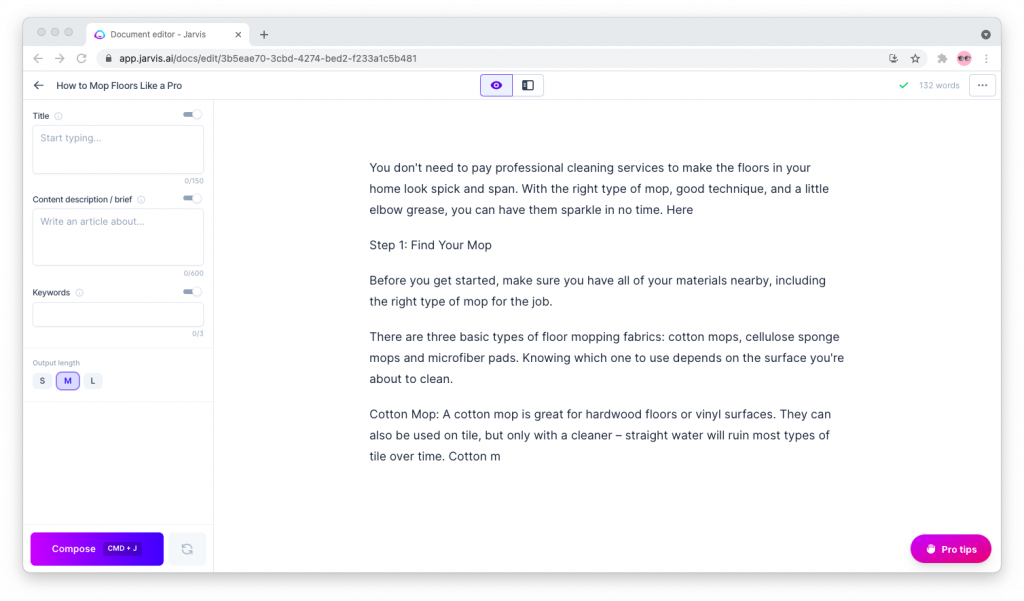
Writing with Jarvis Pro is a bit like a dance.
You type in a few hundred characters—about as much as a longer tweet—then hit Command + J (or the purple “Compose” button on the bottom left corner of the screen), and Jarvis does the writing for you by appending your work with its outputs.
This dance isn’t necessarily easy, and it takes some time to learn.
Sometimes, it yields good outcomes. Othertimes, Jarvis churns out misleading guidance or incorrect facts. So you’ll need to act as a human editor and fact-checker throughout the whole time.
Just notice the nonsense advice on mopping tile floors that Jarvis gave in the final paragraph of my example above:
A cotton mop is great for hardwood floors or vinyl surfaces. They can also be used on tile, but only with a cleaner – straight water will ruin most types of tile over time.
Jarvis AI
Unless you’re on the lookout for random trails of thought like these, your robot-generated content can confuse— and annoy the heck out of—your human readers.
This is not a drawback to Jarvis per se. It’s something you need to be mindful of when using any AI copywriting assistant.
Jarvis can also go off in directions you don’t really expect it to. So, in some cases, the fact that you have to type a few hundred characters to get a few hundred characters back, only to have to do it again, can be counterproductive and downright tiring.
You can remove that limitation—and have Jarvis do 99.9% of the writing for you, on command, with little to no inputs, whenever you decide to—if you upgrade to Boss Mode.
Jarvis Boss Mode ($119/month)
The “Boss Mode” plan costs $119/month, and it lets you make the most of Jarvis’ copywriting capabilities by using Jarvis Commands to direct the tool to write whatever piece of content, short- or long-form, you need.
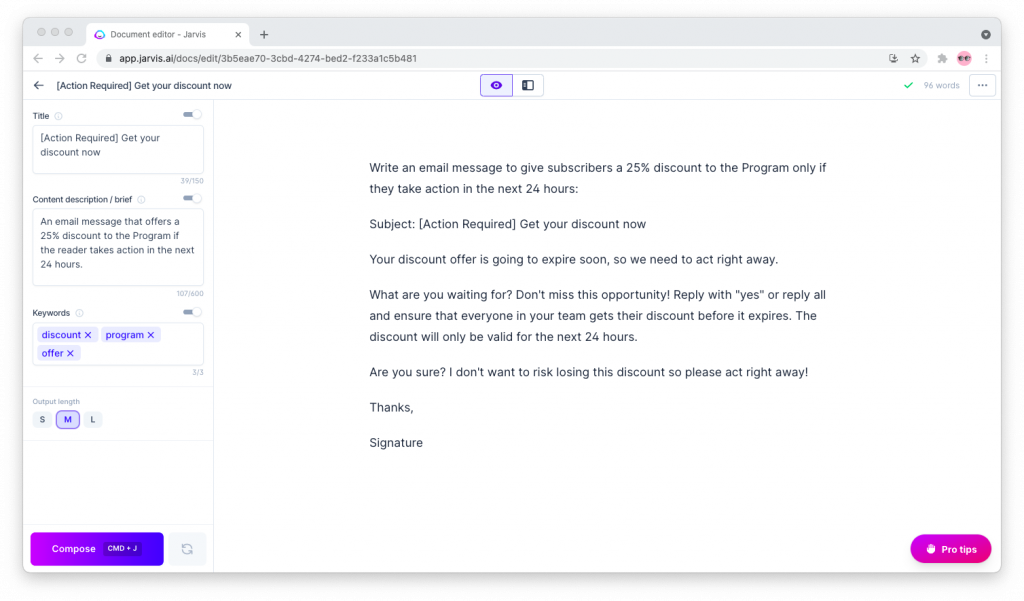
Jarvis Commands let you interact with the AI copywriting assistant in a way that’s very similar to how you already talk to Alexa, Google, or Siri at home.
Here are a few ideas for Jarvis Commands to type in:
- For your blog
- Write some blog post titles about {your topic}
- Write a blog post outline for {your post’s title}
- Write a blog post intro for {your post’s title}
- For your YouTube channel
- Write some YouTube titles about {your topic}
- Write a video script outline for {your video’s title}
- Write a video hook and intro for {your post’s title}
You can also make Jarvis Commands for short-form copywriting templates, like “Run Content Improver on the above” or “Rewrite the above to explain to a 5th grader,” so that you don’t have to navigate back-and-forth in the app.
If you know how to code, this is like using a console. But, unlike coding, the outputs from your commands can never be guessed, and always different, even if you run the same command twice.
Still, don’t expect every piece of content to be Pulitzer-worthy.
When you haven’t given it enough inputs or it has a hard time interpreting them, Jarvis will generate lesser-grade copy or spew out random characters that only make sense in “AI land:”
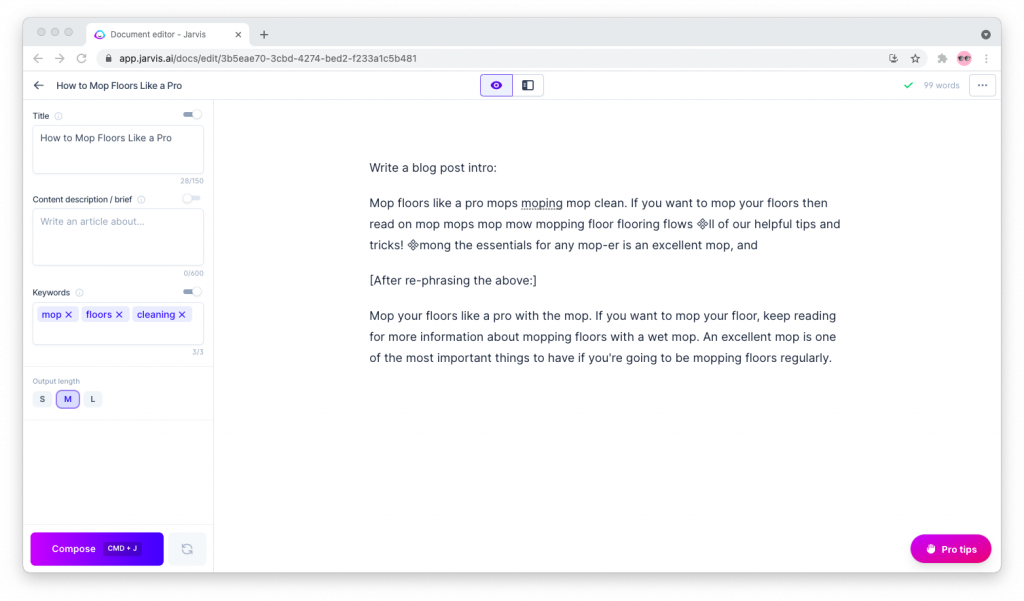
The Boss Mode lets you hit the “Compose” button (or Command + J) an unlimited number of times, without having to type in a few hundred characters first as you’re required to do when subscribed to Jarvis Pro.
At $109/month and $119/month when billed monthly, the price difference between Jarvis Pro and Jarvis Boss Mode is not really all that big.
Unlimited runs and Jarvis Commands give you the most value for the money, so readers looking for my two cents can skip the Pro plan altogether and go directly to Boss Mode.
Pros of Jarvis
- Jarvis has 50+ copywriting templates for all kinds of use cases from Google and Facebook ads to blog posts and YouTube videos.
- Powered by GPT-3, Jarvis generates engaging and coherent copy (despite that, the copy requires thorough fact-checking);
- Compared to all other tools in its category, Jarvis has the most functional and easiest to use interface.
Cons of Jarvis
- The Starter ($29/mo) plan is limited, and the Pro ($109/mo) and Boss Mode ($119/mo) plans are expensive;
- The long-form copywriting assistant in Pro takes time to get used to, and requires you to write text every few hundred characters;
- Jarvis Commands are still in their early days and, even if use the Boss Mode Cheat Sheet, you don’t always get good results.
What Is Rytr?
Rytr is an AI copywriting assistant that, just like Jarvis, is powered by the GPT-3 algorithm. Priced at $29/month for unlimited generation and priority support, it’s also the most affordable writer out there.
At the time of publishing this post, Rytr supported 30+ languages, 20+ tones of voice, and 20+ use cases (heads up: what Jarvis calls “copywriting templates,” Rytr calls “use cases,” and I use both terms interchangeably).
These use cases include, among others, generating outlines and paragraphs for blog posts, writing subject lines and message bodies for marketing emails, coming up with landing page copy, writing SEO titles and descriptions, as well as YouTube ideas and descptions.
A web app, you use Rytr by visiting app.rytr.me in your browser. Once you’re logged in, you see a clean, minimalist text editor that reminds you of an email client:
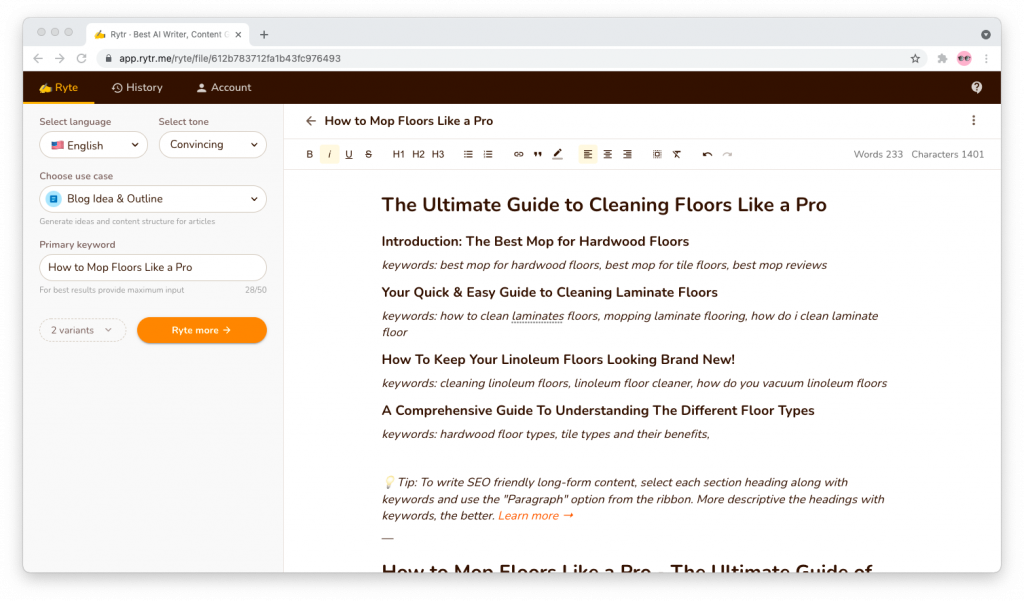
Similar to Jarvis Commands, Rytr Commands enable you to instruct the AI to write—and rewrite—content for you.
Simply type in your command and hit Command + Shift + C (or highlight the text and select “Command” from the contextual menu that pops up). Rytr will try to understand what you asked it to do, and will automatically type in the outputs:

Just like a calculator has mathematical operations, which you can use to add, subtract, multiple, or divide numbers, you can interact with Rytr (other than the freeform Rytr Commands) through a few AI copywriting operations:

At any point in time, you can choose to rephrase a chunk of text to make it sound different, improve it in grammar and readability, expand it, shorten it, or append a few words at the end of it. You can also check the selected text for plagiarism (powered by Copyscape).
There are limits to the amount of text that you can select. For example, most operations only work on selections between 30 and 300 characters, and you can run a Copyscape check only on text between 100 and 1,600 characters.
In terms of the quality of the generated text that you get, Rytr isn’t marginally better—or marginally worse—than Jarvis.
It has less templates than Jarvis and most tasks take a click or two more but, when you consider that an year of Rytr Premium costs as much as a month of Jarvis Boss Mode, it’s great value for the money.
How Much Does Rytr Cost?
As someone who’s not fond of catches and upsells, one thing that instantly made me fell in love with Rytr was its pricing model. It’s so simple, it will take you no more than a minute or two to understand it.
Basically, there’s a free plan and a paid plan (which lets you add additional users at a cost). The free plan has a monthly character limit, the paid plan doesn’t. Both of the plans give you access to all of Rytr’s features in their entirety.
| Plan / Features | Rytr Free | Rytr Premium |
|---|---|---|
| Price | Free | $29/month |
| Price per additional user | N/a | $19/month |
| Limits | 5,000 characters per month | Unlimited |
| 30+ languages | Yes | Yes |
| 20+ use cases | Yes | Yes |
And that, along with the details below, is pretty much all you need to know!
Rytr Free
Rytr Free, which you can keep using forever, gives you access to all languages and copywriting templates but imposes a cap on content generation of 5,000 words/month.
Rytr Premium ($29/month)
Rytr Premium, the tool’s only paid plan, costs $29/month billed monthly or $290 annually. It gives you access to all of the languages and copywriting templates, and has no character limits whatsoever.
Suppose you’re part of an agency or editorial team, and you need more than one person to use Rytr. You can add additional users for $19/month billed monthly or $190/year paid for annually.
Rytr Pros
- Powered by GPT-3, the same AI text generation algorithm that Jarvis uses, Rytr generates compelling and coherent texts;
- At $29/month for unlimited characters, Rytr is the most affordable AI copywriting assistant for its quality on the market;
- The text editor is easy to use and lets you generate long-form content through pre-defined use cases or freeform commands.
Rytr Cons
- Facebook, Google, and LinkedIn Ads are grouped under a single use case, giving you less control over format and copy than Jarvis;
- Rytr can generate long-form copy with very few inputs, but it takes quite a few clicks and operations to write a thousand-word post;
- You can only select from one tone of voice, and can’t combine multiple to generate a “witty” and “helpful” chunk of text.
Jarvis vs. Rytr
Is either of these tools significantly better than the other? Or, at the end of the day, does it come down to whose user experience, copywriting templates, and/or price you like the most?
For the sake of example, let’s suppose I had a blog about cleaning (I don’t). I want an AI copywriting assistant that can help me write helpful and informative, but also funny and witty, posts.
And both Jarvis and Rytr are on top of my list. Let’s give each of them a spin to see how their outputs compare to one another.
For Writing Blog Post Titles
To test how good these tools are at coming up with killer titles, I opened up a blank document in each and instructed them with the following freeform command: “Give me ideas for titles for a blog post about mopping floors.”
So far, so good: both of the AI copywriting assistants had understood my intent, just as their creators advertise, and came up with several ideas for blog post titles.
Here’s what these ideas were:


Rytr had gotten slightly off-track by coming up with a title for steam-cleaning (instead of mopping floors), but the rest of its ideas were spot-on. Some of them were so good, I had a hard time picking!
Jarvis, on the other hand, came up with “drier” titles and, looking at the ideas for stainless-steel floors and solutions to the worst flooring problems, it had gone astray quite a bit more than its cheaper counterpart.
After careful consideration on my end, Rytr won. I decided that my blog post’s title would be “The Ten Commandments of Mopping Floors.”
For Writing Blog Post Introductions
Next, it was time for me to come up with an introduction.
Unsurprisingly, my second freeform command to our two robotic contestants was: “Write an introduction to a blog post titled, ‘The Ten Commandments of Mopping Floors.'”
The outputs, far from perfect, kept me entertained:


I don’t know how Jarvis came up with “Mop mop mop mop mop mop mop mop!” as a way to start the intro, but I laughed out loud, and—while I would have repeated the word less times had I come up with this myself—I nevertheless thought it was brilliant.
The rest of the intro was not as good. If I were writing a real post, I’d probably ask Jarvis to iterate on it a few times, giving it the occasional rewrite or input for direction, until I got to something that would make me want to keep on reading.
Rytr had taken the canned, “a mop is a staple in every household” approach, so no prize for creativity compared to Jarvis here (at least not for this run). Its intro, though somewhat off-track, was well-versed and pretty engaging.
Rytr’s second output made up for the lack of creativity of the first, giving me an interesting idea to start each of the ten commandments on my listacle with “Thou shalt not” in an attempt to make the whole piece stand out from the rest of the articles out there.
Who won?
I don’t think there’s a clear winner for this task. Each tool’s outputs required a hefty amount of rewriting to be considered usable in a “real” blog post.
They gave me inspiration, but they also created additional work for me. Had I taken the time to write an introduction myself, it probably would have come out better.
For Creating Blog Post Outlines
We had a title and an introduction. Now, it was time for the outline.
To make sure I got the best results from Jarvis and Rytr, I closed their long-form editors and opened up their copywriting templates for the job, feeding them with the same requirements.
I simplified the task down to “The 10 rules for mopping floors,” requesting an outline with an “informative” tone of voice in 2 variants from both.
Let’s see what I got back:


Jarvis gave an actionable outline of six rules for mopping floors, whereas Rytr gave only four. So it seems like neither AI copywriting assistant had taken my ask to generate an outline containing ten rules seriously.
The outline generated by Jarvis was easier for me to immediately use for writing content. Rytr had tried to do too many things at the same time, giving me a title, a list, and even keywords to rank for, which I found a little distracting.
This one goes to Jarvis because it did exactly what I expected it to. I could take each of the sentences on the outline and copy/paste them into the long-form editor with the goal to turn them into a proper post.
For Writing Parts of Blog Posts
Time for our final round of the showdown.
I asked Jarvis and Rytr to generate content for a part of my blog post with the heading “How to Sweep the Floor.”


I consider this a tie. Both writers gave back equally good (and, depending on how you look at them, equally bad) content that needed a bit of rework before it could be added to a post.
Neither of these tools, as you can tell from the side-by-side test above, is perfectly capable of writing text on its own. (Still, that’s no reason to discard them: AI learns fast and, some day, they may leave most copywriters without a job.)
But they can be real lifesavers when you can’t find the words or are feeling lazy.
Who Should Get Jarvis?
If you work in an agency, retailer, or big brand, and you’re looking for a an AI copywriting assistant to bolster your team’s content ideation for your ad copy, product listings, or email marketing campaigns, by all means, go for Jarvis and get the Boss Mode subscription.
The same applies for content creators, whether bloggers, Instagram influencers, or YouTubers, who want to get an AI copywriting assistant for their posts’ titles, descriptions, and content, and who can afford to pay a higher price for their tools.
Who Should Get Rytr?
If you’re a freelancer copywriter, a copywriting agency, or a content creator who’s not keen on spending a thousand or more dollars on an yearly subscription for any tool, get Rytr Premium.
Under the bonnet, Rytr’s powered by GPT-3, the same AI algorithm that Jarvis uses. Though Jarvis has more templates and a more powerful long-form document editor, it can’t beat Rytr’s price.

